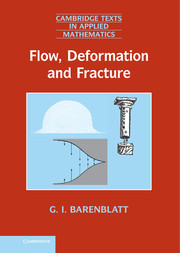 Flow, Deformation and Fracture
Flow, Deformation and Fracture Book contents
- Frontmatter
- Dedication
- Contents
- Foreword
- Preface
- Introduction
- 1 Idealized continuous media: the basic concepts
- 2 Dimensional analysis and physical similitude
- 3 The ideal incompressible fluid approximation: general concepts and relations
- 4 The ideal incompressible fluid approximation: analysis and applications
- 5 The linear elastic solid approximation. Basic equations and boundary value problems in the linear theory of elasticity
- 6 The linear elastic solid approximation. Applications: brittle and quasi-brittle fracture; strength of structures
- 7 The Newtonian viscous fluid approximation. General comments and basic relations
- 8 The Newtonian viscous fluid approximation. Applications: the boundary layer
- 9 Advanced similarity methods: complete and incomplete similarity
- 10 The ideal gas approximation. Sound waves; shock waves
- 11 Turbulence: generalities; scaling laws for shear flows
- 12 Turbulence: mathematical models of turbulent shear flows and of the local structure of turbulent flows at very large Reynolds numbers
- References
- Index
Introduction
Published online by Cambridge University Press: 05 June 2014
- Frontmatter
- Dedication
- Contents
- Foreword
- Preface
- Introduction
- 1 Idealized continuous media: the basic concepts
- 2 Dimensional analysis and physical similitude
- 3 The ideal incompressible fluid approximation: general concepts and relations
- 4 The ideal incompressible fluid approximation: analysis and applications
- 5 The linear elastic solid approximation. Basic equations and boundary value problems in the linear theory of elasticity
- 6 The linear elastic solid approximation. Applications: brittle and quasi-brittle fracture; strength of structures
- 7 The Newtonian viscous fluid approximation. General comments and basic relations
- 8 The Newtonian viscous fluid approximation. Applications: the boundary layer
- 9 Advanced similarity methods: complete and incomplete similarity
- 10 The ideal gas approximation. Sound waves; shock waves
- 11 Turbulence: generalities; scaling laws for shear flows
- 12 Turbulence: mathematical models of turbulent shear flows and of the local structure of turbulent flows at very large Reynolds numbers
- References
- Index
Summary
The purpose of the present book is to give an idea about fundamental concepts and methods, as well as instructive special results, of a unified intermediate asymptotic mathematical theory of the flow, deformation and fracture of real fluids and deformable solids. This theory is based on a quite definite and, we emphasize, idealized approach where the real materials are replaced by a continuous medium; therefore it is often called the mechanics of continua. It generalizes, and represents from a unified viewpoint, more focused disciplines: fluid dynamics, gas dynamics, the theory of elasticity, the theory of plasticity etc. For various reasons these disciplines underwent separate development for a long time. The splendid exceptions found in the work of A. L. Cauchy, C. L. M. H. Navier and A. Barré de Saint-Venant in the nineteenth century and L. Prandtl, Th. von Kármán, and G. I. Taylor in the twentieth century confirm rather than disprove the general rule. Therefore the teaching of the mechanics of continua and, more generally, the maintaining of interest in the mechanics of continua as a unified scientific discipline was, in this period of fragmentation, the job of physicists, who considered it to be a necessary part of a complete course of theoretical physics. So it was not by accident that among those who created courses in mechanics of continua were outstanding physicists: M. Planck, A. Sommerfeld, V. A. Fock, Ya. I. Frenkel, L. D. Landau and E. M. Lifshitz and, more recently, L. M. Brekhovskikh.
The physicists were more interested, however, in general ideas and methods rather than in the consistent presentation of special, even very important, results, which in fact give true shape to the subject.
- Type
- Chapter
- Information
- Flow, Deformation and FractureLectures on Fluid Mechanics and the Mechanics of Deformable Solids for Mathematicians and Physicists, pp. 1 - 9Publisher: Cambridge University PressPrint publication year: 2014
